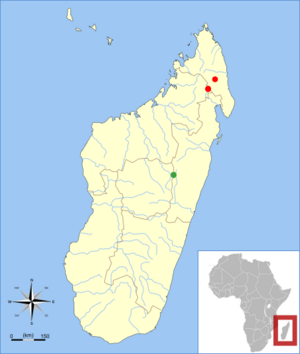Eastern voalavo facts for kids
Quick facts for kids Eastern voalavo |
|
|---|---|
| Conservation status | |
| Scientific classification | |
| Genus: |
Voalavo
|
| Species: |
antsahabensis
|
 |
|
| Known records of Voalavo antsahabensis (green) and Voalavo gymnocaudus (red) | |
The eastern voalavo (Voalavo antsahabensis) is a small rodent that lives in the forests of eastern Madagascar. It's a special kind of mouse found only on this island. Even though scientists didn't find it until 2002, it's quite common in some parts of its home. Sadly, its home is shrinking because of habitat loss, mainly due to a farming method called slash-and-burn agriculture. The eastern voalavo was officially named in 2005. It's very closely related to the northern voalavo, which is the only other species in the Voalavo family.
The two types of voalavos look very similar. The eastern voalavo is a small rodent, weighing about 20.7 to 22.6 g (0.73 to 0.80 oz). It has a longer tail than the northern voalavo. It also has a longer snout (the front part of its skull). The gap between its front teeth and back teeth is also longer. However, its rows of chewing teeth are shorter. There are also small differences in the roof of its mouth.
Contents
Discovering the Eastern Voalavo
Scientists first found the eastern voalavo in 2002. They captured three of these small rodents in Madagascar's Anjozorobe forest. In 2005, a scientist named Steven Goodman and his team officially described the species. They named it Voalavo antsahabensis.
This was the second species found in the Voalavo group. The first one was the northern voalavo, which lives further north. The name antsahabensis comes from the village of Antsahabe. This village is close to where the first eastern voalavo was found.
How They Are Related
The eastern voalavo and northern voalavo are very close relatives. Scientists looked at their DNA. They found about a 10% difference in a specific gene called cytochrome b. This difference helps show they are two distinct species.
What Does the Eastern Voalavo Look Like?
Voalavos are small rodents. They have a delicate skull. Unlike some related mice, their tails do not have a tuft of hair at the end. The eastern voalavo looks a lot like the northern voalavo. The differences are very small.
Size and Features
The eastern voalavo has a slightly shorter tail than its northern cousin. However, its head and body might be a bit longer. Its ears also seem a little longer. These measurements can sometimes be tricky to compare. The last 25 to 30 mm (0.98 to 1.18 in) of their tails are covered with white hairs.
Here are some measurements for three eastern voalavo specimens:
- Head and body length: 88 to 91 mm (3.5 to 3.6 in)
- Tail length: 106 to 114 mm (4.2 to 4.5 in)
- Hindfoot length: 19 to 20 mm (0.75 to 0.79 in)
- Ear length: 15 to 16 mm (0.59 to 0.63 in)
- Body mass (weight): 20.7 to 22.6 g (0.73 to 0.80 oz)
Skull Differences
The eastern voalavo's skull has a longer snout. This is the front part of the skull. It also has a longer gap between its front teeth and its back teeth. Its rows of chewing teeth are shorter in both the upper and lower jaws.
The openings in the front part of the roof of its mouth are rounded. In the northern voalavo, these openings are more angular. The lines where the bones of the skull join are straight in the eastern voalavo. In the northern voalavo, these lines are more curved. Scientists can tell the two species apart by carefully measuring their skulls and teeth.
Where Do Eastern Voalavos Live?
The eastern voalavo is only found in the forests of Anjozorobe. This area is on the eastern edge of Madagascar's Central Highlands.
Their Forest Home
In 2002, two eastern voalavos were caught high up in a tree. They were about 1.5 m (4.9 ft) off the ground. They were in a moist mountain forest. Another one was caught on the ground. This male voalavo was old enough to reproduce. However, its skull bones were not fully grown, meaning it was still developing.
Scientists had surveyed the Anjozorobe forest before 2002. They looked for animals in 1977-1986 and 1996. But they never found the eastern voalavo. It's not clear why. Maybe they are hard to catch. Or perhaps their numbers change each year. It's also possible they live in specific, scattered areas. This shows that quick surveys might not find all the animals in an area. Later surveys in 2005 and 2006 found them in many other places. In some spots, they were very common.
Separated by Distance
Anjozorobe is about 450 km (280 mi) away from where the northern voalavo lives. Most of the land between them is mountain forest. However, a low-lying area called the Mandritsara Window cuts through this forest. This area might act as a natural barrier. It could keep the two types of voalavos from meeting and mixing.
Protecting the Eastern Voalavo
The eastern voalavo is listed as "Endangered" on the IUCN Red List. This means it is at high risk of extinction. Its home range is small and easily harmed. The Anjozorobe forest is in danger because of slash-and-burn agriculture. This farming method, called tavy, involves cutting down and burning trees.
However, there is good news. The eastern voalavo's habitat has been made a protected area. It is now part of the Couloir Forestier d'Anjozorobe-Angavo. This protection helps keep their forest home safe.


